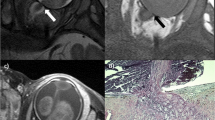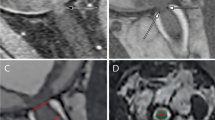Abstract
Objectives
To assess the accuracy of high-resolution (HR) magnetic resonance imaging (MRI) in diagnosing early-stage optic nerve (ON) invasion in a retinoblastoma cohort.
Methods
This IRB-approved, prospective multicenter study included 95 patients (55 boys, 40 girls; mean age, 29 months). 1.5-T MRI was performed using surface coils before enucleation, including spin-echo unenhanced and contrast-enhanced (CE) T1-weighted sequences (slice thickness, 2 mm; pixel size <0.3 × 0.3 mm2). Images were read by five neuroradiologists blinded to histopathologic findings. ROC curves were constructed with AUC assessment using a bootstrap method.
Results
Histopathology identified 41 eyes without ON invasion and 25 with prelaminar, 18 with intralaminar and 12 with postlaminar invasion. All but one were postoperatively classified as stage I by the International Retinoblastoma Staging System. The accuracy of CE-T1 sequences in identifying ON invasion was limited (AUC = 0.64; 95 % CI, 0.55 – 0.72) and not confirmed for postlaminar invasion diagnosis (AUC = 0.64; 95 % CI, 0.47 – 0.82); high specificities (range, 0.64 – 1) and negative predictive values (range, 0.81 – 0.97) were confirmed.
Conclusion
HR-MRI with surface coils is recommended to appropriately select retinoblastoma patients eligible for primary enucleation without the risk of IRSS stage II but cannot substitute for pathology in differentiating the first degrees of ON invasion.
Key Points
• HR-MRI excludes advanced optic nerve invasion with high negative predictive value.
• HR-MRI accurately selects patients eligible for primary enucleation.
• Diagnosis of early stages of optic nerve invasion still relies on pathology.
• Several physiological MR patterns may mimic optic nerve invasion.





Similar content being viewed by others
Abbreviations
- HR-MRI:
-
High-resolution MRI
- ON:
-
Optic nerve
- IRSS:
-
International Retinoblastoma Staging System
References
Doz F, Brisse H, Stoppa-Lyonnet D, Sastre X, Zucker J-M, Desjardins L (2004) Retinoblastoma. In: Pinkerton R, Plowman P, Pieters R (eds) Paediatric oncology. Arnold, London, pp 323–338
Shields CL, Meadows AT, Leahey AM, Shields JA (2004) Continuing challenges in the management of retinoblastoma with chemotherapy. Retina 24:849–862
Shields CL, Shields JA, Baez K, Cater JR, De Potter P (1994) Optic nerve invasion of retinoblastoma. Metastatic potential and clinical risk factors. Cancer 73:692–698
Sastre X, Chantada GL, Doz F et al (2009) Proceedings of the consensus meetings from the International Retinoblastoma Staging Working Group on the pathology guidelines for the examination of enucleated eyes and evaluation of prognostic risk factors in retinoblastoma. Arch Pathol Lab Med 133:1199–1202
Khelfaoui F, Validire P, Auperin A et al (1996) Histopathologic risk factors in retinoblastoma: a retrospective study of 172 patients treated in a single institution. Cancer 77:1206–1213
Aerts I, Sastre-Garau X, Savignoni A et al (2013) Results of a multicenter prospective study on the postoperative treatment of unilateral retinoblastoma after primary enucleation. J Clin Oncol 31:1458–1463
Hungerford J (1993) Factors influencing metastasis in retinoblastoma. Br J Ophthalmol 77:541
Brisse HJ, Guesmi M, Aerts I et al (2007) Relevance of CT and MRI in retinoblastoma for the diagnosis of postlaminar invasion with normal-size optic nerve: a retrospective study of 150 patients with histological comparison. Pediatr Radiol 37:649–656
Magramm I, Abramson DH, Ellsworth RM (1989) Optic nerve involvement in retinoblastoma. Ophthalmology 96:217–222
Chantada G, Doz F, Antoneli CB et al (2006) A proposal for an international retinoblastoma staging system. Pediatr Blood Cancer 47:801–805
Freeman CR, Esseltine DL, Whitehead VM, Chevalier L, Little JM (1980) Retinoblastoma: the case for radiotherapy and for adjuvant chemotherapy. Cancer 46:1913–1918
Zelter M, Damel A, Gonzalez G, Schwartz L (1991) A prospective study on the treatment of retinoblastoma in 72 patients. Cancer 68:1685–1690
Schvartzman E, Chantada G, Fandino A, de Davila MT, Raslawski E, Manzitti J (1996) Results of a stage-based protocol for the treatment of retinoblastoma. J Clin Oncol 14:1532–1536
Doz F, Khelfaoui F, Mosseri V et al (1994) The role of chemotherapy in orbital involvement of retinoblastoma. The experience of a single institution with 33 patients. Cancer 74:722–732
de Graaf P, Goricke S, Rodjan F et al (2012) Guidelines for imaging retinoblastoma: imaging principles and MRI standardization. Pediatr Radiol 42:2–14
Bellaton E, Bertozzi AI, Behar C et al (2003) Neoadjuvant chemotherapy for extensive unilateral retinoblastoma. Br J Ophthalmol 87:327–329
Lumbroso-Le Rouic L, Aerts I, Levy-Gabriel C et al (2008) Conservative treatments of intraocular retinoblastoma. Ophthalmology 115:1405–1410
de Graaf P, Barkhof F, Moll AC et al (2005) Retinoblastoma: MR imaging parameters in detection of tumor extent. Radiology 235:197–207
Lemke AJ, Kazi I, Mergner U et al (2007) Retinoblastoma-MR appearance using a surface coil in comparison with histopathological results. Eur Radiol 17:49–60
Ainbinder DJ, Haik BG, Frei DF, Gupta KL, Mafee MF (1996) Gadolinium enhancement: improved MRI detection of retinoblastoma extension into the optic nerve. Neuroradiology 38:778–781
Schueler AO, Hosten N, Bechrakis NE et al (2003) High resolution magnetic resonance imaging of retinoblastoma. Br J Ophthalmol 87:330–335
Barkhof F, Smeets M, van der Valk P et al (1997) MR imaging in retinoblastoma. Eur Radiol 7:726–731
de Jong MC, de Graaf P, Noij DP et al (2014) Diagnostic performance of magnetic resonance imaging and computed tomography for advanced retinoblastoma: a systematic review and meta-analysis. Ophthalmology 121:1109–1118
Wilson MW, Rodriguez-Galindo C, Billups C, Haik BG, Laningham F, Patay Z (2009) Lack of correlation between the histologic and magnetic resonance imaging results of optic nerve involvement in eyes primarily enucleated for retinoblastoma. Ophthalmology 116:1558–1563
Song KD, Eo H, Kim JH, Yoo SY, Jeon TY (2012) Can preoperative MR imaging predict optic nerve invasion of retinoblastoma? Eur J Radiol 81:4041–4045
Lee BJ, Kim JH, Kim DH, Park SH, Yu YS (2012) The validity of routine brain MRI in detecting post-laminar optic nerve involvement in retinoblastoma. Br J Ophthalmol 96:1237–1241
Chawla B, Sharma S, Sen S et al (2012) Correlation between clinical features, magnetic resonance imaging, and histopathologic findings in retinoblastoma: a prospective study. Ophthalmology 119:850–856
Reese AB, Ellsworth RM (1963) The evaluation and current concept of retinoblastoma therapy. Trans Am Acad Opthalmol Otolaryngol 67:164–172
Shields CL, Mashayekhi A, Au AK et al (2006) The international classification of retinoblastoma predicts chemoreduction success. Ophthalmology 113:2276–2280
Ruskell GL (1997) Peripapillary venous drainage from the choroid: a variable feature in human eyes. Br J Ophthalmol 81:76–79
Sirin S, Schlamann M, Metz KA et al (2013) Diagnostic image quality of gadolinium-enhanced T1-weighted MRI with and without fat saturation in children with retinoblastoma. Pediatr Radiol 43:716–724
Shields CL, Pellegrini M, Ferenczy SR, Shields JA (2014) Enhanced depth imaging optical coherence tomography of intraocular tumors: from placid to seasick to rock and rolling topography: the 2013 Francesco Orzalesi Lecture. Retina 34:1495–1512
Rootman DB, Gonzalez E, Mallipatna A et al (2013) Hand-held high-resolution spectral domain optical coherence tomography in retinoblastoma: clinical and morphologic considerations. Br J Ophthalmol 97:59–65
Yousef YA, Shroff M, Halliday W, Gallie BL, Heon E (2012) Detection of optic nerve disease in retinoblastoma by use of spectral domain optical coherence tomography. J AAPOS 16:481–483
Acknowledgments
The scientific guarantor of this publication is Dr Hervé J. Brisse. The authors of this manuscript declare no relationships with any companies whose products or services may be related to the subject matter of the article. Ophthalmologists: C Levy, L Lumbroso-Le Rouic, N Cassoux, M.I. Bosscha; Paediatricians: F Doz, W.A. Kors; Radiographer: S Lasalle; Biostatistics technicians: N Algret.
This study received funding from: The ODAS Foundation, Delft, The Netherlands (mailing, traveling costs, data management); and The RETINOSTOP foundation, Paris, France (data management, statistical analysis). Two of the authors (KC, AS) have significant statistical expertise. Institutional Review Board approval was obtained. Written informed consent was waived by the Institutional Review Board. Methodology: prospective, diagnostic, multicentre study.
Author information
Authors and Affiliations
Consortia
Corresponding author
Rights and permissions
About this article
Cite this article
Brisse, H.J., de Graaf, P., Galluzzi, P. et al. Assessment of early-stage optic nerve invasion in retinoblastoma using high-resolution 1.5 Tesla MRI with surface coils: a multicentre, prospective accuracy study with histopathological correlation. Eur Radiol 25, 1443–1452 (2015). https://doi.org/10.1007/s00330-014-3514-1
Received:
Revised:
Accepted:
Published:
Issue Date:
DOI: https://doi.org/10.1007/s00330-014-3514-1




